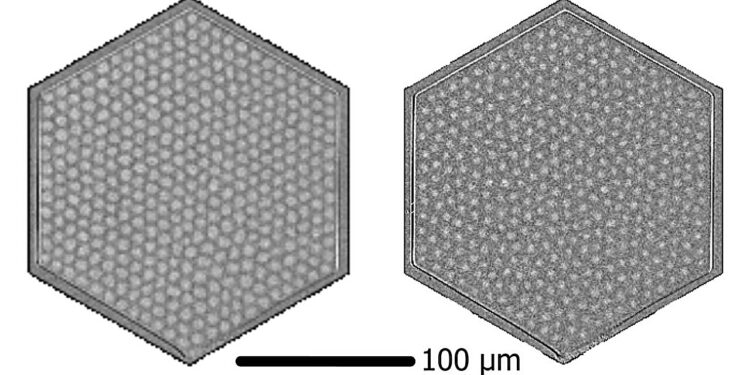Instantanesses from the Skyrmion network during the merger: a Skyrmion network ordered on the left while the structure of the network has disappeared on the right. Credit: Raphael Gruber
What happens during the fusion process in two-dimensional systems at the microscopic level? Researchers from the University of Johannes Gutenberg MAPIED (JGU) explored this phenomenon in fine magnetic layers.
“Using Skyrmiires, that is to say miniature magnetic whirlwinds, we were able to directly observe, for the first time, the transition from a two-dimensional ordered network structure in a disorderly state at the microscopic level in real time,” said Raphael Gruber, who conducted research in the working group of Professor Mathias Kläui at the JGU Institute.
The results, published in Nanotechnology of natureare fundamental for a deeper understanding of the two -dimensional fusion processes and the behavior of Skyrmions, which could revolutionize future storage technologies.
Maisse in two stages of the Skyrmion networks
Although the concept of ice melting into water is familiar with most from a macroscopic point of view, microscopic aspects of fusion processes remain surprisingly misunderstood.
“This phase transition is particularly intriguing in two -dimensional systems, where distinct phenomena emerge, differing from those observed in three -dimensional counterparts,” said Gruber.
Initially, the researchers have generated Skyrmions, which are magnetic vortex structures similar to microscopic hurricanes, by precision temperature and magnetic fields. Due to their remarkable stability, Skyrmiions can be considered as individual entities. When they are densely packed, these magnetic swirls self-organize in an ordinary network structure.
“Our main question was: what happens when we return this state ordered to a disorderly state-indeed, when we melt the system?” said Gruber.
Using a magneto-optical Kerr microscope, the researchers observed this process in real time for the first time. Unlike three -dimensional network structures, such as ice cream, the twormion -dimensional Skyrmion network melts in a distinctive two -step process. During the initial stage, the translation order is lost, with individual Skyrmions remaining in a network, but presenting irregular distances to their nearest neighbors. It is only in the next step that the orientation is also compromised, culminating in the complete dissolution of the network – a fusion process.
“The elucidation of this merger transition has been greatly facilitated by our collaboration with colleagues from the Center for Quantum Spintronics from the Norwegian University of Sciences and Technology,” noted Professor Mathias Kläui.
Maisse induced by the magnetic field: a new approach
A distinctive aspect of this experimental conception lies in the method used to induce fusion. As a rule, the temperature would be increased. However, this approach is sub-optimal in this context, because it would modify the conditions giving birth to magnetic swirls.
“Instead, we have reduced the size of the Skyrmions by modulating the magnetic field. This approach has enabled Skyrmiites mobility greater mobility in the network, which allows a movement,” said Gruber. “This strategy, similar to the increase in temperature, leads to the structure of the gradually disorderly network, ultimately leading to its complete dissolution.”
These results open the way to the potential application of Skyrmines in future data storage technologies, offering significantly improved data density, quick reading / writing access and exceptional energy efficiency.
More information:
Raphael Gruber et al, real -time observation of the dynamics of topological defects mediating the fusion of the twormion -dimensional Skyrmion network, Nanotechnology of nature (2025). DOI: 10.1038 / S41565-025-01977-2
Supplied by Universitaet Mainz
Quote: Scientists capture real -time fusion of 2D Skyrmion networks using magnetic fields (2025, August 4) recovered on August 5, 2025
This document is subject to copyright. In addition to any fair program for private or research purposes, no part can be reproduced without written authorization. The content is provided only for information purposes.



